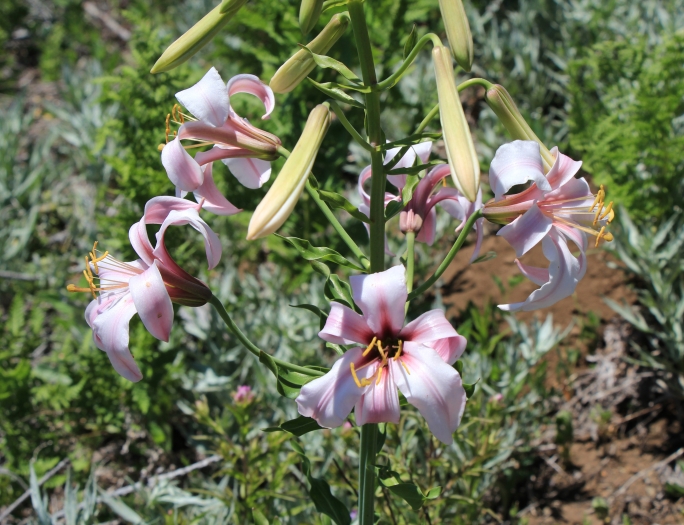Washington Lily
(Lilium washingtonianum)
Washington Lily (Lilium washingtonianum)
/
/

Paul McClellan
CC BY 4.0
Image By:
Paul McClellan
Recorded By:
Copyright:
CC BY 4.0
Copyright Notice:
Photo by: Paul McClellan | License Type: CC BY 4.0 | License URL: http://creativecommons.org/licenses/by/4.0/ | Rights Holder: Paul McClellan | Publisher: iNaturalist | Date Created: 2021-07-04T13:55:56-07:00 |










Estimated Native Range
Summary
Lilium washingtonianum, commonly known as the Washington lily or Shasta lily, is a perennial herb that is native to the mountainous regions of the Cascade Range and Sierra Nevada in California and Oregon. This species typically grows to a height of 2 to 7 feet and is characterized by its strikingly tall and erect form. The Washington lily produces large, fragrant flowers that are white, often fading to pinkish with age, and are spotted with purple or brown. These trumpet-shaped blooms appear in the flowering season from late spring to midsummer and are highly showy, attracting pollinators such as hummingbirds.
The Washington lily is appreciated for its ornamental value, with its large, fragrant, and showy flowers making it a desirable addition to native plant gardens, woodland gardens, and naturalized areas. It prefers well-drained soils, moderate water, and can thrive in full sun to part shade conditions. While it is not commonly used for urban planting due to its specific habitat requirements, it is an excellent choice for gardeners looking to create a naturalistic setting. Gardeners should be aware that this lily requires good drainage and may be susceptible to fungal diseases if conditions are too wet. It is also important to note that the bulbs of Washington lily are edible and were historically consumed by Native American tribes in its native region.CC BY-SA 4.0
The Washington lily is appreciated for its ornamental value, with its large, fragrant, and showy flowers making it a desirable addition to native plant gardens, woodland gardens, and naturalized areas. It prefers well-drained soils, moderate water, and can thrive in full sun to part shade conditions. While it is not commonly used for urban planting due to its specific habitat requirements, it is an excellent choice for gardeners looking to create a naturalistic setting. Gardeners should be aware that this lily requires good drainage and may be susceptible to fungal diseases if conditions are too wet. It is also important to note that the bulbs of Washington lily are edible and were historically consumed by Native American tribes in its native region.CC BY-SA 4.0
Plant Description
- Plant Type: Herb, Bulb
- Height: 2-8 feet
- Width: 1-2 feet
- Growth Rate: Moderate
- Flower Color: Pink, White
- Flowering Season: Summer
- Leaf Retention: Deciduous
Growth Requirements
- Sun: Full Sun, Part Shade
- Water: Medium
- Drainage: Medium
Common Uses
Border Plant, Fragrant, Low Maintenance
Natural Habitat
Native to mountainous regions of the Cascade Range and Sierra Nevada in California and Oregon
Other Names
Common Names: Washington Lily, Mt Hood Lily, Shasta Lily
Scientific Names: , Lilium washingtonianum, Lilium washingtonianum var. washingtonianum,
GBIF Accepted Name: